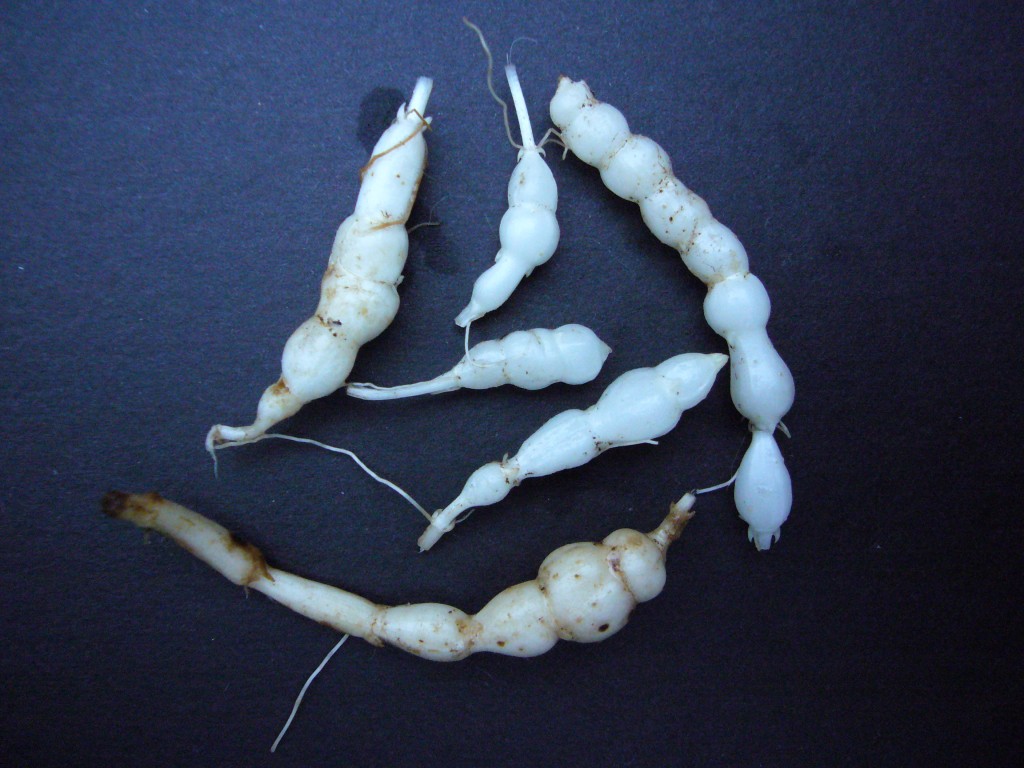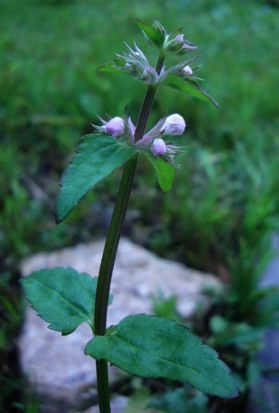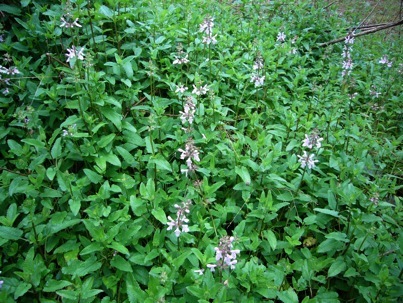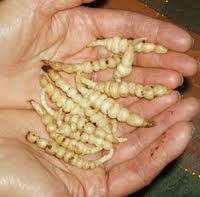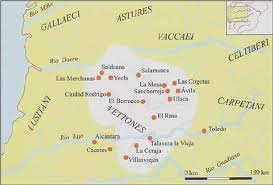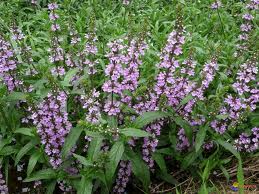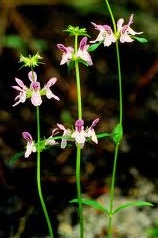Stachys Floridana, Culinary Pretender
I have read from a good source that all Stachys are edible. I politely doubt that for three reasons. First there are 300 to 450 of them depending on who’s counting. It’s doubtful all of them would be edible. The roots of one defintely are not edible. Next, many were used for medicinal purposes which also suggest some are not edible, and even if they were medicine often tastes bad. Lastly, and perhaps the most compelling reason, is that who’s in the family and who’s out is in flux. Botanists are a fickle lot. It could make things more iffy particularly if a non-Stachys non-edible was included as a Stachys. But, what I do know is our local Stachys is edible and bears an underground resemblance to a relative that commands high prices.
Stachys floridana, (STAY-kis flo-ri-DAN-ah) the Florida Betony, is one of the most common urban plants found in Florida. Sun and a moist lawn are magnets for the versatile weed. The above ground parts — read young plants and leaves — can be cooked like greens. They are, however, musty in flavor. Think of them as a famine food. Tea can be made from the dried leaves and the seeds are edible. But, the crowning glory of the Florida Betony, so to speak, is its root, actually a tuber. These cunchy, tasty treats look like big, fat, white grubs. Others think they look like the noisy end of a rattle snake hence the other common name, Rattle Snake Weed. Pictured above are some small, early season roots. The Florida Betony puts on a tuber in spring and then kind of takes the hot summer off to return in the fall. In late spring the tubers are often stark white. In the fall they can be tan and in time get soft and not palatable.
These humble tubers infest many a southern lawn and literally millions of dollars are spent every year to get rid of them: Read a lot of herbicide use. Another family member, Stachy affinis, aka Crosnes, does not have that problem. They sell for about $150 a pound. Actually, I’ve never seen a crosnes growing in Florida. It was originally from China, went to France in the town of Crosnes, and from there to the fancy Paris restaurants. That brought it to cultivation in and around New York City.
In restaurants of stars, Stachys affinis, also called Chinese Artichokes, are hard-to-get gourmet delicacies. It makes one wish Florida Betony could be substituted. I’d like the idea of having a few thousand dollars of these in my lawn. Maybe it’s a totally untapped market. Someone should let the chefs know there is a possible alternative. No doubt a good price break could be worked out, say… $100 a pound.
The Florida Betony is a good example of attitude and knowledge. First is a willingness to eat the weeds, a theme dear to the author’s heart. The other is benefiting from that knowledge. The Florida Betony is the poor root of the pair, not able to command $150 a pound. It even has a different number of chromosomes than the S. affinis (this genus is in flux.) But, the Betony is good eats. I don’t have to pay $150 a pound for the S. affinis when I can get the S. floridana for free. Pass the salt and pepper please.
There is also one other known use for the Florida Betony. It is a source of a sugar called Stachyose, according to its manufacturer, Schuttl et Benth. It is less sweet than sugar and is used as a bulk sweetener. It is also not completely digestible. Stachyose promotes friendly bacteria in the gut and — according to research — can inhibit the growth of bacteria that can cause some pneumonia and vaginal infections. Tasty and healthy. That’s a win win.
Stachys is from Greek meaning “stake” or in this case a flower spike. Floridana means of Florida. “Betony” has a long linguistic history. And for this it helps to remember that in olden days letters were not pronounced the same way as they are now. Even today in Greek the B has a V sound. The original name for Betony was Vettonica. It was named after an Iberian tribe, the Vettones (living in now what is northwest Spain.) The Vettones, however, were Celtic — read proto-Irish — and lent their name to Breton, Brittany, Britain and even the encyclopedia no one buys anymore. The Vettones were thought by the Romans to posses special medicinal magic that drove away bad spirits. A common Roman proverb for someone troubled was, “sell your coat and buy betony.” Most of the plants in the mint family that were named Betonica are now called Stachys. Affinis (ahf-EYE-niss) is Latin for “similar to.”
No one does nutritional research on the Florida Betony. However, nutrition for the S. affinis per 100 grams is: Calories 75, total fat 0, dietary fiber 2 grams, protein 2.6 grams, carbohydrate 17 grams, cholesterol (mg) 0, sodium (mg) 4, sugars (g) o.
Incidentally, if you live in a northern clime two other Stachys with edible tubers are available. The first is Stachys palustris, the Marsh Woundwort. It can be found in the northeast quadrant of North America, basically the Mason Dixon Line north and as far west as Illinois and Manitoba. The tubers can be cooked in a variety of ways, or dried and made into bread, and the young
shoots are cooked and eaten like asparagus. The second, according to Dr. Francois Couplain, is the Stachys hyssopifolia, the Hyssopleaf Hedgenettle (say that 10 times fast.) It’s found in states that border the Atlantic as well as Kentucky, Indiana, illinois, Iowa and Michigan. Seeds of the Stachys scopulorum were eaten by natives in the desert southwest of North America and Stachys sylvatica is consumed in Europe, and about New York City.
The roots of Stachys officinalis are not edible. They are bitter and can make you throw up.
Green Deane’s “Itemized” Plant Profile
IDENTIFICATION: Florida Betony is square-stemmed, erect, hairy; tubers are segmented and resemble a rattlesnake’s rattle, usually little finger long; The stems up to 18 inches tall. Simple leaves opposite on the stem. The flowers occur in clusters of 3-6, sepals fused, forming a tube which is hairy, with 5 lanceolate lobes. The petals are fused, 2-lipped. The upper lip is somewhat erect. The lower lip is 3-lobed.
TIME OF YEAR: The best roots are fat and ready to eat before Florida’s hot summer begins. Roots near surface usually many found together. During the hot months the plant can disappear to reemerge in fall. In northern climates the roots are harvest in the cool of fall.
ENVIRONMENT: Moist yet well-drained areas, such as lawns.
METHOD OF PREPARATION: Roots raw or cooked, crispy in salads, great in stir fries. Leaves and shoots of the plant can also be eaten raw or cooked. They are, however, rather musty tasting and best mixed with other greens. The Indians reportedly ate the seeds as a famine food. Some say the flavor of the tubers are like cauliflower where as I lean toward jicama. The texture, however, is like a radish. Lastly, the leaves of some Stachys species were smoked like tobacco. The roots of the Florida Betony also have chemicals which have “antioxidant activity. “

